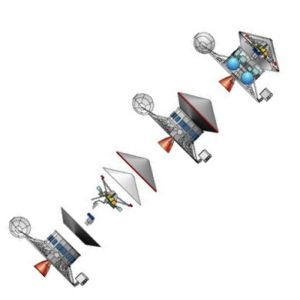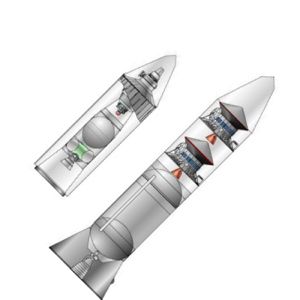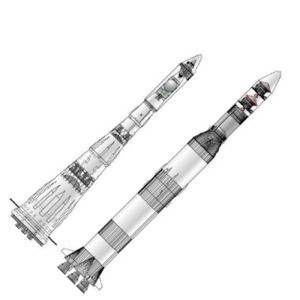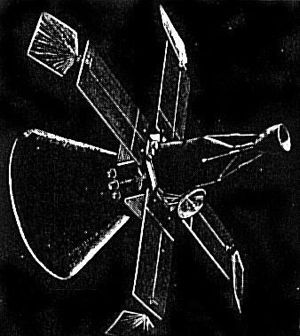
Home - Search - Browse - Alphabetic Index: 0- 1- 2- 3- 4- 5- 6- 7- 8- 9
A- B- C- D- E- F- G- H- I- J- K- L- M- N- O- P- Q- R- S- T- U- V- W- X- Y- Z
Voyager 1973
 Voyager 1973 Voyager spacecraft. Top, cross section. Center, outer view. Bottom, exploded view of modules. Credit: © Mark Wade |
Status: Cancelled 1967. Gross mass: 11,700 kg (25,700 lb). Unfuelled mass: 4,900 kg (10,800 lb). Height: 7.20 m (23.60 ft). Diameter: 6.10 m (20.00 ft).
An orbiter would comprehensively map and study the surface, while a lander would search for life on the surface. After Mariner 4 revealed the Martian atmosphere was much thinner than previously believed, the lander had to incorporate rocket braking, and grew beyond the capability of the Saturn IB. So the program was reconfigured in 1965 to launch two 11 metric ton Voyagers to Mars at once aboard a single Saturn V launch in 1973. Congress killed the program in 1967 before a full-scale development contractor could be selected. NASA managed to accomplish nearly the same mission in 1975 using two Viking spacecraft launched by Titan 3C-Centaur boosters.
Technical Description of Voyager
The final plans for Voyager prior to its cancellation in late 1967 were as follows:
- Preliminary design of the orbiter was completed in 1966 and that for the lander was to be completed in 1967. System design for both components and final selection of experiments to be carried for the 1973 launch would be accomplished in 1968. Advanced development, qualification test, and construction of the first flight articles would extend from 1969 to 1973.
- Single Saturn V launches would be made at each Mars launch window in 1973, 1975, 1977, and 1979. The total payload would be 25,100 kg for the first launch, increasing to 26,300 kg in 1975 and 27,700 kg in 1977 and 1979. Each launch would propel two independently-operating Voyager spacecraft toward the planet.
- On arrival at Mars, the orbiters would brake into initial 12-hour orbits around Mars.
- After verifying the weather conditions and landing site, each orbiter would be commanded to release its lander.
- The deorbit section of each lander would orient the lander and then fire to brake it by 275 m/s. One to three hours after deorbit, the deorbit section would be released and the lander oriented for re-entry.
- The landing sequence had some latitude due to uncertainties regarding the Martian atmosphere. Re-entry would occur at 3700 to 4600 m/s. After slowing to between 120 and 300 m/s at an altitude of 4600 m, the aeroshell would be jettisoned. The lander would descend thereafter on pure rocket power, with vertical velocity being braked to zero 3 m above the surface. The lander would be allowed to fall from this height to minimize contamination of the landing site. During the 4.5 to 9 minute descent, data and video would be radioed back to earth. The atmospheric composition would be sampled and analyzed during all phases of re-entry and descent, and the pressure and temperature measured.
- The lander would conduct surface operations from two days (on the first missions) to two years (on the later missions) designed to identify and characterize life on Mars. These would include surface rovers on the later missions.
- Orbiter: 1100 kg target weight dry. Propellant capacity of 6,800 kg, providing a typical total delta-V of 2,000 m/sec. Three axis attitude stabilized, powered by 25 sq m of solar cells providing 1 kW of power to rechargeable batteries of 3 to 4 kW-hrs capacity. Data storage was to be 1 to 10 gigabits, and data rate to earth using the high gain antenna, 8,000 to 15,000 bits/seconds. 200 kg of science instruments would consist of video cameras, spectrometers, radiometers, ionospheric sounders, and polarimeters.
The orbiter would conduct visual mapping and topography, map planetary temperature distribution, observe daily and seasonal changes on the surface, study the planet's geology, gravity, geodesy, large-scale atmospheric features - and biology. The orbiter would approach as low as 1150 km to the surface, in orbits with periods of from 6 to 12 hours. Its planned lifetime was six months on the early mission, extended to two years on later missions.
- Lander: 5900 kg weight in the first 1973 mission. This would grow to 6300 kg in the 1975 missions and 6800 kg on the 1977 and 1979 missions. The lander was enclosed in a sealed canister for sterilization purposes. The canister cover over the aeroshell was jettisoned when the lander separated from the orbiter, with the canister base remaining attached to the orbiter. The lander itself consisted of an aeroshell, and on the first missions, a Surveyor-style lander. Later missions would use encapsulated landers for long-duration surface stays and deploy small rovers to retrieve and analyze sample some distance from the landing point.
The lander weight included 20% contingency for growth during development. The 4000 kg design weight was allocated to three subsystems:
- The sterilization canister and propulsion system for stabilization and de-orbit after separation from the orbiter had a total mass of 1275 kg.
- The mass allocated to landing on the surface - including the aeroshell, dedicated communications, guidance, power, and the rocket braking system - was 850 kg. The aeroshell had a diameter of 6.1 m and a ballistic coefficient of 50 kg/sq m. During the 4.5 to 9 minute descent, data and video would be radioed back to earth. The atmospheric composition would be sampled and analyzed during all phases of re-entry and descent, and the pressure and temperature measured. The result was expected to be a complete pressure-altitude, temperature-altitude, and composition-altitude profile of the Martian atmosphere. Video would also be sent back of the surface as the lander attempted its soft landing. The instruments provided for this phase included a video camera, accelerometers, pressure transducers, temperature probes, and mass spectrometers.
- The surface payload, including telecommunications, nuclear thermal power supply, and 150 kg of science instruments, was 860 kg. Instruments were to include a video camera, gas chromatograph, mass spectrometer, radiometer, life detection experiments, and ultraviolet and alpha scatter spectrometers. These would allow Voyager to provide data on incident radiation, surface chemical composition, biochemistry of the surface, the biological environment of the planet, direct tests for the presence of life, and probing beneath the surface.
The lander could send data to earth at 600 bits per second directly, or 50,000 to 200,000 bps by relaying through the orbiter. The early missions would be battery-powered with 5 kW-hr batteries, and therefore limited to two days of operation . Later missions would allow use of robust landers powered by nuclear thermal generators, capable of six months to two years of operation, with deployable rovers.
- The total mass launched by the Saturn V included the 9300 kg payload shroud/adapter and another 1200 to 2300 kg of contingency - so the project had generous margins!
History of Voyager
The origins of Voyager can be traced back to the earliest post-Sputnik US studies on the course of a future space program. At this time, rather than defining missions to be accomplished, the constraint was what launch vehicles would be available, and what payloads they could hurl to various destinations in the solar system. On 18 July 1958 NACA's National Integrated Missile and Space Vehicle Development Program considered that their 'Type IV' launch vehicle (equivalent to the later Saturn C-3) would be used to send a 2300 kg 'probe' to Mars in January 1967, followed by one to Venus four months later. NASA's December 1959 'Ten Year Plan of the National Aeronautics and Space Administration' concentrated on unmanned and manned exploration of the moon, however. Heavyweight 2300 kg Saturn-launched lander probes to the planets were not foreseen until the 1970's. Voyager was identified by name in the spring of 1960 in the NASA semi-annual report to Congress. Voyager was to be the second generation planetary spacecraft after Mariner, capable of orbiting and landing capsules on Mars or Venus. Preliminary studies were underway, it was reported, but final planning would have to await decisions and funding for development of the Saturn I launch vehicle (at that time planned to have a Centaur-derived third stage, the S-V). This version of Voyager would be limited to 1090 kg, including a small landing capsule of 100 to 150 kg.
JPL planners began to study Voyager-class missions in 1961, followed by a May 1962 study of advanced missions and spacecraft. These came to two conclusions -- that too little was known about the atmosphere of either planet to design a lander at that time, and the largest wish-list of instruments that would be the payload for an orbiter came to 230 kilograms. Neither of these conclusions pointed to a heavy spacecraft in the short-term. They also identified major areas of technical development needed for any such future missions - improvements in the deep-space tracking and control network, development of sterilization methods to ensure that earth spacecraft did not contaminate other potentially life-bearing planets, and improvements in solar and nuclear thermal power generation.
NASA's Donald Hearth found all of this too cautious. He required intrusive amounts of paperwork from JPL in order to know what they were up to, while informally asking several companies to study unmanned Mars landers at their own expense. These included the usual suspects - Avco, General Electric (ballistic missile re-entry vehicle specialists), Douglas, Convair, Lockheed, North American, and Space Technology Laboratories. Heath was hell-bent on achieving a landing on Venus by June 1967. NASA called for issued a request for proposal for Voyager Design Studies to 21 bidders on 5 March 1963. In those days things moved fast. The industrial briefing to 37 prospective contractors and subcontractors was held six days later. On 25 March, 13 companies submitted bids. These were examined by a selection board two days later, and by 4 April General Electric and Avco were informed they would be receiving modest $ 125,000 and $ 144,546 study contracts.
The concept was for a Voyager Venus launch in 1967, followed by one to Mars in 1969. Progress was dogged by continuing hostility between JPL and NASA headquarters. JPL felt that working on a lander was premature. Some JPL astronomers had concluded that the atmosphere of Mars might be much thinner than assumed. Values for the Martian surface-level atmosphere pressure as low as 1% that of earth were mentioned, compared to over ten times that estimated previously. As a result of this 'pessimism', NASA terminated JPL's Advanced Planetary Spacecraft Study on 1 September 1963 and gave Avco and General Electric an extra month to consider the impact of a lower surface pressure for the design of their landers.
Hearth presented the case for Voyager to NASA Administrator James Webb in December 1963. The new uncertainty regarding atmospheric pressure had killed JPL's alternative, low-end Mariner B lander. To land in the lower pressure, the capsule for that concept would have to weigh more than the planned Atlas Centaur booster could handle. Therefore the only alternative, he said, to press on with Saturn-I launched Voyager. Both Avco and General Electric had come up with excellent lander designs, which would deliver 70 to 91 kg of instruments to the Martian surface. They would be targeted to the 'green' areas of Mars showing the greatest seasonal change and be equipped with miniature laboratories to determine the nature of life on Mars.
General Electric planned to carry 657 two landers on one 934 kg orbital bus. The orbital bus would include 939 kg of propellant, bringing the total spacecraft mass to 3187 kg. The landers would be shaped like GE's conical ICBM re-entry vehicles. They would use rockets for final braking and deploy tip bars to right themselves on the surface. Landing targets for 1969 were Syrtis Major (10 deg N, 285 deg longitude) and Pandorae Fretum (24 deg S, 310 deg longitude).
The Avco spacecraft had a total mass of 2961 kg, including 1361 of propellant, the 838 kg orbiter, and the single 762 kg lander. The latter consisted of a jettisonable aeroshell for re-entry and a spherical hard lander built to take a parachute-braked 12 m/s landing shock. After bouncing across the surface, it would unfurl itself on six petals (remarkably similar to the Soviet Luna E-6 lander which had begun its long series of attempts to reach the moon earlier that year). Nuclear thermal generators would provide power. Avco planned to land at no less than ten different locations on Mars during four launch campaigns in 1969-1975. These ranged from Syrtis Major to both polar caps.
But Webb refused to give the go-ahead. Apollo had the priority, and cutbacks to even Apollo were already coming. America's space program was heading toward its decline. So it was back to JPL's more modest plans for interim Mariner orbiter missions. Voyager could only be fully funded in the post-moon landing budgets. This would push the first launch back to 1971.
However Congressional unhappiness with the string of JPL Ranger failures and the waning support for the space program meant that NASA could not support funds for both JPL's Mariner-Mars 1969 and Heath's Voyager 1971. So NASA cancelled Mariner-Mars 69 in order to save the $1.25 billion Voyager project. Voyager was officially authorized to proceed on 16 December 1964. Requests for proposal for a prime contractor were issued on 15 January 1965. JPL's role was limited at that point to supervision of the preliminary design phase of the program. The 22 January bidder's conference was attended by 28 companies. By 3 May three down-selected companies began work on the 90-day preliminary design phase: Boeing, General Electric, and TRW. One would receive a final production contract.
On 15 July 1965 came the shocking findings of Mariner 4, the first spacecraft to flyby Mars and return data. The atmospheric pressure at the surface was as low as 0.4% of that of earth - essentially a vacuum, and under half that of even JPL's most pessimistic assumption. It would be impossible to land a significant payload on the surface without using a larger, heavier lander using rocket braking for touchdown. NASA bit the bullet and announced in mid-October 1965 that development of the Saturn IB-Centaur would be terminated and that Voyager would be launched by the Saturn V. However the existing production Saturn V's were allocated to the Apollo moon landings. This, together with funding limits and delays necessary to redesign the lander, meant that the first Voyager flight would have to be delayed to 1973. A single Saturn V launch would boost two Voyager probes to Mars.
The change took the sense of urgency out of the program, and JPL remained hostile to trying to build a spacecraft on such a grand, revolutionary scale. After a long series of failures in the first half of the 1960's, they had finally begun to achieve success through incremental changes to proven spacecraft designs. Voyager funding was drastically cut, but work on refining the spacecraft design and identifying missions in the 1973-1979 period continued. On 17 October 1966 the decision was taken to put Von Braun's Marshall Spaceflight Center in charge of development of both Voyager and its modified Saturn V launch vehicle. JPL's role would be limited to working with NASA Langley on lander subsystems. Voyager struggled on a bit longer, but Congress was now finding little favor with new high-cost space projects. On 22 August 1967, the House approved a NASA budget that totally eliminated all funds for Voyager. President Johnson did not fight the deletion.
Voyager was resurrected as the faster-better-cheaper Viking project. This developed a new Titan 3C-Centaur booster in replacement of the Saturn IB-Centaur cancelled by NASA and landed the two successful Viking landers on Mars in 1975, long after the last Saturn V had flown.
Family: Mars lander. Country: USA. Launch Vehicles: Mars tactical rocket, Saturn V. Agency: JPL, NASA. Bibliography: 590.
 | Voyager vs 5NM Voyager contrasted with 5NM in their Saturn V / N1 launch shrouds Credit: © Mark Wade |
 | Voyager vs 5NM The N1 and Saturn V launch vehicles of 5NM and Voyager contrasted. Credit: © Mark Wade |
 | Voyager - Saturn V Credit: NASA |
1965 November 18 - .
- Saturn IB/Centaur Office named changed to Saturn Applications. - .
Nation: USA.
Program: Skylab.
Spacecraft: Voyager 1973.
John H. Disher, Saturn/Apollo Applications Deputy Director, requested the Manned Space Flight Management Operations Director to officially change the designation of the Saturn IB/Centaur Office to Saturn Applications. This change, Disher said, reflected the change in status of the office and provided for necessary management of potential Saturn Applications such as the Saturn V/Voyager by the Office of Manned Space Flight. However, on the same day, Disher ordered E. F. O'Connor at MSFC to halt all Saturn IB/Centaur efforts (except those already underway that could not be recalled) and disapproved the request for an additional $1.1 million for the program. (Any funds required for definition of a Saturn V/Voyager mission, he said, would be authorized separately.)
1967 July 26 - .
- Webb refuses to make substantial cuts in either the Apollo Applications or Voyager programs. - .
Nation: USA.
Related Persons: Webb.
Program: Skylab.
Spacecraft: Orbital Workshop,
Voyager 1973,
Skylab.
NASA Administrator Webb refuses to make choice between substantial cuts in either the Apollo Applications or Voyager programs. NASA Administrator James E. Webb testified on the NASA FY 1968 authorization bill before the Senate Committee on Appropriations' Subcommittee on Independent Offices. Asked by Sen. Spessard Holland (D Fla.) to make a choice between a substantial cut in funding for the Apollo Applications Program and the Voyager program, Webb replied that both were vital to the U.S. space effort. Additional Details: here....
Back to top of page
Home - Search - Browse - Alphabetic Index: 0- 1- 2- 3- 4- 5- 6- 7- 8- 9
A- B- C- D- E- F- G- H- I- J- K- L- M- N- O- P- Q- R- S- T- U- V- W- X- Y- Z
© 1997-2019 Mark Wade - Contact
© / Conditions for Use